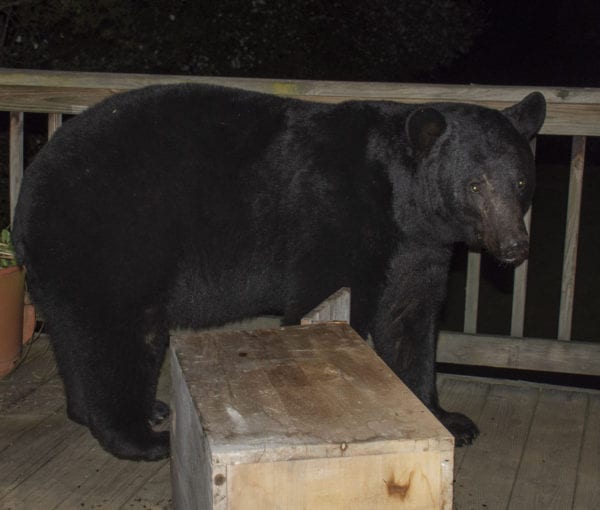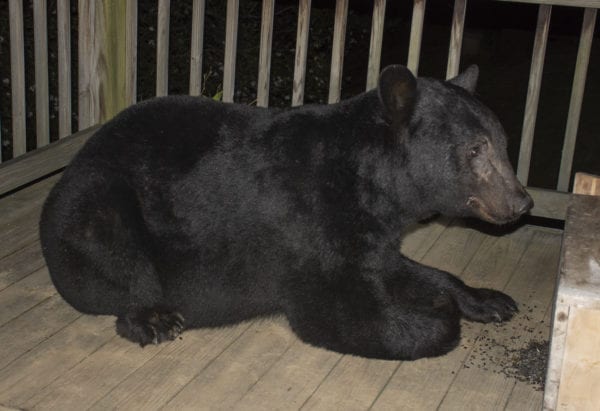
By Tim Gardner
With so many roaming throughout the North Carolina High Country, the North Carolina Wildlife and United States Forest Service Officials remind those who live here and visitors to the area to practice simple safety steps to avoid black bear encounters. Black bears are the only species of bears in the Eastern United States, including North Carolina. Black bear sightings are more common in the spring and early-to-mid summer when they have come out of winter hibernation and search for food. This also is the time when young bears, called transient bears, are looking for a new home after being pushed away by the adult female bear as she begins breeding again.
Usually black bears are seen in more remote areas, but it’s not uncommon for them wander into towns or cities. If left alone, most bears that have wandered into a residential area will quickly retreat to their natural habitat, particularly if no food source is found.
Seeing a bear can be a special treat and many are fascinated with these creatures. While it is an exciting moment, it is important to remember that bears are wild and can be dangerous. Their behavior is often unpredictable. Although rare, bear attacks on humans have occurred, inflicting serious injuries and even death. Every bear and each experience is unique; there is no single strategy that will work in all situations that guarantees safety when you get near a bear. According to wildlife and forest service officials, most bear encounters end without injury. But the safety of those who get near a bear may depend on their ability to calm the bear.
“No matter where you are or where you live, if you encounter a bear, the most important thing to do is leave the bear alone–that can’t be stressed enough,” said Daniel Ray, the N.C. Wildlife Commission’s biologist for District 8, which includes Avery County. “Most people don’t realize that bears are usually more afraid of humans than humans are of bears. And bears are more of a nuisance than they are a danger if they are left alone. But people can unnerve a bear, perhaps causing it to act defensively. And while bears may appear to be wandering aimlessly around, they are not necessarily lost. Most are simply exploring their surroundings and will move on, particularly if they are left alone and they find no food.”
Following viewing etiquette is the first and most important step to avoiding an encounter with a bear that could escalate into an attack. Much like coming near a poisonous snake or other dangerous, wild creatures, it’s best to not surprise a bear and make any attempt to get near it, as Ray noted.
Most bears will avoid humans if they hear them coming. Pay attention to your surroundings and make a special effort to be noticeable if you are in an area with known bear activity or a good food source, such as berry bushes. But once a bear has noticed you, additional strategies can help prevent the situation from escalating. Wildlife officials recommend talking calmly so the bear realizes you are a human and not a prey animal, Remain still; stand your ground, but slowly wave your arms. Help the bear recognize you as a human. It may come closer or stand on its hind legs to get a better look or smell. A standing bear is usually only curious, not threatening.
Stay calm and remember that most bears do not want to attack you; they just want to be left alone. Bears may bluff their way out of an encounter by charging and then turning away at the last second and running away from you. Bears may also react defensively by woofing, yawning, salivating, growling, snapping their jaws, and laying their ears back. If this happens, wildlife experts suggest that you continue to talk to the bear in low tones; this will help you stay calmer, and it won’t be threatening to the bear. Any sudden movement may trigger an attack. Also, never try to imitate bear sounds when seeing a bear. That can make a bear think you plan to hurt it and make it become very aggressive and defensive.
Other recommendations when in any area where bears may be prevalent is for adults to keep children immediately by their sides and to pick up small children immediately when getting near a bear. Also, it is advised for hikers and others to remain in groups. Groups of people are usually noisier and smellier than a single person. Therefore, bears often become aware of groups of people at greater distances, and because of their cumulative size, groups are also intimidating to bears.
If the bear is stationary, move away slowly and sideways; this allows you to keep an eye on the bear and avoid tripping. Moving sideways is also non-threatening to bears. Do not attempt to run from a bear. The average weight of a black bear is 300 pounds and some can weigh as much as 600 pounds. But despite their large frames and weight, bears can run as fast as a racehorse both uphill and down, making it extremely difficult to outrun them. Like dogs, they will chase fleeing animals. Do not climb a tree. Black bears can climb trees and will do so in pursuit once they consider you a threat.
Leave the area or take a detour if a bear comes into view. If this is impossible, wait until the bear moves away. Be especially cautious if you see a female with cubs; never place yourself between a mother and her cub, and never attempt to approach them. The chances of an attack escalate greatly if the Mama bear perceives you as a danger to her cubs.
Most bears are only interested in protecting food, cubs or their space. Never try to block an escape route for them and do not attempt to fight a black bear unless it has attacked you.
But if you are attacked by a black bear, try to escape to a secure place such as a car or building. If escape is not possible, try to fight back using any object available. Concentrate your kicks and blows on the bear’s face and muzzle.
If any bear attacks you in your tent, or stalks you and then attacks, also do not play dead—fight back. This kind of bear attack is very rare, but can be serious because it often means the bear is looking for food and considers you and any other humans with you as prey. Never allow a bear access to your food or attempt to feed them. Doing so will only encourage the bear to come closer to you and others who may be with you.
There is a bear pepper spray available that can be purchased at stores that sell guns, camping supplies and related items or ordered online. It can be an important thing to carry when exploring the back country. It is used defensively to stop an aggressive or attacking bear. Although it’s used in the same manner you would use mace on an attacking person, bear pepper spray and human pepper spray are not the same. Make sure you select an EPA approved product that is specifically designed to stop bears. It is not a repellent so do not apply to your body or equipment. Check with a park ranger or wildlife officer to find out if bear pepper spray is recommended or allowed for the activities you have planned.
Forest and wildlife authorities recommend avoiding camping and hiking alone in back country regions—especially in the dark as bears often ramble around then. If camping in national forest or parks, check with the ranger’s office for any bear advisories. And help protect others by reporting all bear incidents to wildlife or related authorities as soon as possible.
And whether, at your home, or camping, secure food, garbage and recycling. Food and food odors attract bears, so don’t reward them with easily available food or garbage. And do not leave food or garbage inside fire rings at grills at campsites or near cabins. Wipe tabletops clean and never store food and other scented items in a tent, including toothpaste, deodorant and beverages. The smells on, and of, such items attracts bears. Put trash inside cans stored in a garage, shed or other secure area; or use garbage outside cans or trash containers with a secure latching system or that are bear-resistant.
Remove bird feeders when bears are active. Birdseed and other grains have high calorie content making them appealing to bears. Also, never leave pet food outdoors. Feed outdoor pets portion sizes that will be completely eaten during each meal and remove leftover food and food bowls. Besides removing food attractants, residents can install electric fencing, which will protect bee hives, dumpsters, gardens, compost piles and other potential food sources for bears.
For more information regarding bears and other human-wildlife interactions, call the N.C. Wildlife Commission’s Helpline toll-free at 866-318-2401. The call center is open Monday through Friday (excluding holidays) from 8:00 a.m. until 5:00 p.m. Ray strongly suggests for people interested in learning more about bear safety to log onto the bearwise.org web site.



You must be logged in to post a comment.